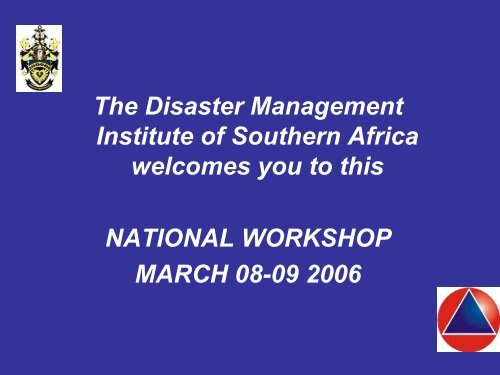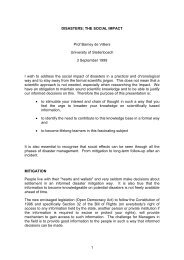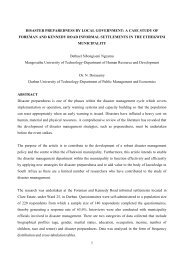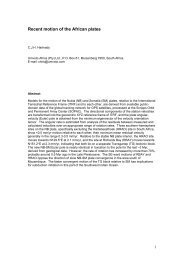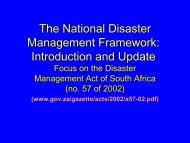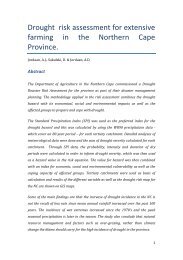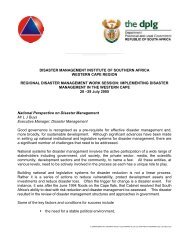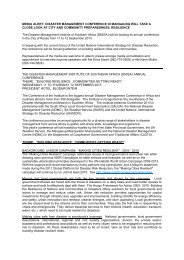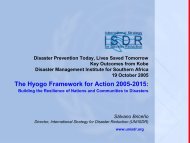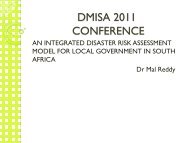Pat Reid - National Workshop : Port Elizabeth - Disaster ...
Pat Reid - National Workshop : Port Elizabeth - Disaster ...
Pat Reid - National Workshop : Port Elizabeth - Disaster ...
Create successful ePaper yourself
Turn your PDF publications into a flip-book with our unique Google optimized e-Paper software.
The <strong>Disaster</strong> Management<br />
Institute of Southern Africa<br />
welcomes you to this<br />
NATIONAL WORKSHOP<br />
MARCH 08-09 2006
• INTRODUCTIONS<br />
• EXPECTATIONS
PROGRAMME<br />
C:\Documents and<br />
Settings\<strong>Pat</strong> <strong>Reid</strong>.000\My<br />
Documents\DMISA\DMISA<br />
Nat WShop prog.XLS
Housekeeping<br />
• Comfort breaks<br />
• Time keeping<br />
• Cell phones<br />
• Ablutions<br />
• Refreshment breaks<br />
• Lunches
Adopting a step by step approach<br />
to phasing in the requirements<br />
of the <strong>Disaster</strong> Management<br />
Act, 2002 and the <strong>National</strong><br />
<strong>Disaster</strong> Management<br />
Framework, 2005<br />
A process developed and<br />
presented by <strong>Pat</strong> <strong>Reid</strong>
Adopting a step by step approach to the implementation of<br />
<strong>Disaster</strong> Risk Management legislation and policy____________<br />
Identifying the key imperatives
Adopting a step by step approach to the implementation of the<br />
<strong>Disaster</strong> Risk Management legislation and policy_______________<br />
Identifying the key imperatives<br />
Make a quick list of<br />
what must be done
Adopting a step by step approach to the implementation of<br />
<strong>Disaster</strong> Risk Management legislation and policy____________<br />
Uniformity<br />
Integration<br />
Joint standards of practice<br />
Cooperation
Adopting a step by step approach to the implementation of<br />
<strong>Disaster</strong> Risk Management legislation and policy____________<br />
The legislative imperatives<br />
The DM Act and the NDMF<br />
Key performance areas<br />
Enablers<br />
Key performance indicators<br />
Levels of plans<br />
Guidelines
Adopting a step by step approach to the implementation of the<br />
<strong>Disaster</strong> Risk Management legislation and policy_______________<br />
• <strong>Disaster</strong> Management Frameworks (Policy)<br />
• <strong>Disaster</strong> Management Centres<br />
• Engagement of Organs of State and other entities (Direction and<br />
Implementation)<br />
• Decentralised arrangements<br />
• Stakeholder participation (Technical advice, Planning and Implementation)<br />
• <strong>Disaster</strong> Risk Assessments<br />
• <strong>Disaster</strong> Management Plans<br />
– <strong>Disaster</strong> Risk Reduction Planning and Implementation<br />
– Contingency Planning and Implementation<br />
• Volunteers<br />
• Information Management System and Reporting<br />
• Communication<br />
• Awareness, Training, Education, Research<br />
• Integration into IDP<br />
• Funding<br />
• AND MORE!
Adopting a step by step approach to the implementation of the<br />
<strong>Disaster</strong> Risk Management legislation and policy___________<br />
Getting your Act together............................
Adopting a step by step approach to the implementation of the<br />
<strong>Disaster</strong> Risk Management legislation and policy______________<br />
Understanding important basics in<br />
respect of:<br />
• Responsibilities for planning<br />
• <strong>Disaster</strong> Risk Assessment<br />
• Components of plans
Adopting a strategic approach to the implementation of the<br />
<strong>Disaster</strong> Risk Management legislation and policy_____________<br />
Understanding important basics<br />
Responsibilities for planning<br />
Who must plan
Adopting a strategic approach to the implementation of the<br />
<strong>Disaster</strong> Risk Management legislation and policy_____________<br />
Understanding important basics<br />
Make a quick list of<br />
Who must plan
Adopting a strategic approach to the implementation of the<br />
<strong>Disaster</strong> Risk Management legislation and policy_____________<br />
Understanding important basics<br />
Who must plan<br />
Provinces – organs of state<br />
Metros - departments and entities<br />
District municipalities - departments and entities<br />
Local municipalities - departments and entities<br />
Municipal Wards<br />
NGOs<br />
Private Sector
<strong>National</strong><br />
<strong>Disaster</strong><br />
Management<br />
Framework<br />
Provincial<br />
DM<br />
Frameworks<br />
DM <strong>Disaster</strong> Management<br />
Information System<br />
Communication, Awareness, Public Information<br />
Risk Mapping monitoring and tracking<br />
Municipal<br />
<strong>Disaster</strong> Management Framework<br />
and Planning Structure<br />
Electronic database<br />
DM Plans of Local<br />
Municipalities and municipal<br />
entities including wards<br />
DM Plans of internal<br />
departments and other<br />
municipal entities of the<br />
Municipality<br />
Municipal <strong>Disaster</strong><br />
Risk Profile<br />
Integrated Development<br />
Plans<br />
Analysis of<br />
potential hazards<br />
Response and<br />
Recovery<br />
Planning<br />
Hazard<br />
Specific<br />
Contingency<br />
Plans<br />
Operational<br />
Plans<br />
Risk Reduction<br />
Planning<br />
Strategic Risk<br />
Reduction<br />
Interventions<br />
Specific Risk Reduction<br />
Programmes and<br />
Projects<br />
Developmental initiatives<br />
for Vulnerability Reduction<br />
Response and<br />
Recovery<br />
Planning<br />
Hazard<br />
Specific<br />
Contingency<br />
Plans<br />
Operational<br />
Plans<br />
Risk Reduction<br />
Planning<br />
Strategic Risk Reduction<br />
Interventions<br />
Specific Risk Reduction<br />
Programmes and Projects<br />
Developmental initiatives<br />
for Vulnerability Reduction<br />
Assessing conditions<br />
of vulnerability<br />
Determining the<br />
level of risk
<strong>National</strong><br />
<strong>Disaster</strong><br />
Management<br />
Framework<br />
DM <strong>Disaster</strong> Management<br />
Information System<br />
Communication, Awareness, Public Information<br />
Risk Mapping monitoring and tracking<br />
Provincial<br />
<strong>Disaster</strong> Management Framework<br />
and Planning Structure<br />
Electronic database<br />
DM Plans of District and<br />
Metropolitan Municipalities<br />
DM Plans of Provincial<br />
organs of state<br />
Indicative <strong>Disaster</strong><br />
Risk Profile<br />
Integrated Development<br />
Plans<br />
Analysis of<br />
potential hazards<br />
Response and<br />
Recovery<br />
Planning<br />
Hazard<br />
Specific<br />
Contingency<br />
Plans<br />
Operational<br />
Plans<br />
Risk Reduction<br />
Planning<br />
Strategic Risk<br />
Reduction<br />
Interventions<br />
Specific Risk Reduction<br />
Programmes and<br />
Projects<br />
Developmental initiatives<br />
for Vulnerability Reduction<br />
Response and<br />
Recovery<br />
Planning<br />
Hazard<br />
Specific<br />
Contingency<br />
Plans<br />
Operational<br />
Plans<br />
Risk Reduction<br />
Planning<br />
Strategic Risk Reduction<br />
Interventions<br />
Specific Risk Reduction<br />
Programmes and Projects<br />
Developmental initiatives<br />
for Vulnerability Reduction<br />
Assessing conditions<br />
of vulnerability<br />
Determining the<br />
level of risk
Adopting a step by step approach to the implementation of the<br />
<strong>Disaster</strong> Risk Management legislation and policy______________<br />
Understanding important basics<br />
Identifying, analysing and assessing<br />
What and Who must be planned for
Identification of risk factor<br />
Stage 1<br />
R<br />
I<br />
S<br />
K<br />
A<br />
N<br />
A<br />
L<br />
Y<br />
S<br />
I<br />
S<br />
Hazards<br />
Determine:<br />
Historical information<br />
Probability<br />
Frequency<br />
Identity<br />
Intensity or scope<br />
Predictability or<br />
forewarning<br />
Exposure<br />
Impact<br />
Associated forces<br />
Manageability<br />
Knock-on effects<br />
Vulnerabilities/<br />
capacities<br />
Determine<br />
susceptibility and<br />
capacity:<br />
Economic<br />
Social<br />
Physical<br />
Environmental<br />
Political<br />
R<br />
I<br />
S<br />
K<br />
A<br />
S<br />
S<br />
E<br />
S<br />
S<br />
M<br />
E<br />
N<br />
T<br />
Stage 2<br />
Estimate level of disaster risk<br />
Evaluate disaster risks<br />
Stage 3<br />
Socio-economic cost-benefit analysis<br />
Establishment of priorities<br />
Establishment of acceptable levels of<br />
disaster risk<br />
Elaboration of scenarios and measures<br />
Stage 4<br />
Monitor Risk Reduction Initiatives<br />
Update and disseminate Risk Assessment<br />
Information
Adopting a step by step approach to the implementation of the<br />
<strong>Disaster</strong> Risk Management legislation and policy_____________<br />
Informed planning<br />
Plan according to DRA findings:<br />
1. Contingency plans for known priority threats<br />
2. Vulnerability reduction planning for common<br />
vulnerabilities<br />
3. Specific risk reduction programmes, projects<br />
and plans for high risk groups, communities,<br />
areas and developments with multiple<br />
vulnerabilities
Adopting a step by step approach to the implementation of the<br />
<strong>Disaster</strong> Risk Management legislation and policy____________<br />
Understanding important basics<br />
What must the plan consist of<br />
Pitch<br />
Scope<br />
Provincial DRM Plans<br />
District DRM Plans<br />
Metro and Local Municipality DRM Plans
•Common<br />
vulnerabilities<br />
•High Risk<br />
groups/<br />
areas/<br />
developments<br />
Municipal <strong>Disaster</strong> Management Framework<br />
<strong>Disaster</strong> Risk Assessment<br />
Findings<br />
Economic<br />
Vulnerabilities<br />
Priority Risks<br />
Municipality<br />
Municipal<br />
departments/<br />
entities<br />
Social<br />
Vulnerabilities<br />
Physical<br />
Vulnerabilities<br />
Soil<br />
Erosion<br />
Floods<br />
Municipal<br />
departments/<br />
entities<br />
Municipality<br />
Risk<br />
Reduction<br />
Planning<br />
Vulnerability<br />
Reduction<br />
Planning<br />
Specific<br />
Risk<br />
Reduction<br />
Projects<br />
Ecological<br />
Vulnerabilities<br />
Political<br />
Vulnerabilities<br />
High Risk<br />
Developments<br />
Local areas/<br />
Communities<br />
with multiple<br />
vulnerabilities<br />
Veld Fires<br />
Drought<br />
Severe<br />
Weather<br />
Events<br />
Response<br />
Management<br />
Early<br />
Warnings<br />
Assessment<br />
Hazard<br />
specific<br />
Contingency<br />
Plans<br />
Operational<br />
plans for<br />
response and<br />
recovery<br />
activities<br />
Public Health<br />
Contingency<br />
Planning<br />
Search and Rescue<br />
Access Routes<br />
Integrated<br />
Development Plan<br />
Emergency Medical Care<br />
Fire Fighting<br />
Evacuation<br />
Shelter<br />
Communication<br />
Public Information<br />
Humanitarian relief<br />
Security
Adopting a step by step approach to the implementation of the<br />
<strong>Disaster</strong> Risk Management legislation and policy_____________<br />
Understanding important basics<br />
How can all of this be phased in
Adopting a step by step approach to the implementation of the<br />
<strong>Disaster</strong> Risk Management legislation and policy______________<br />
Planning the process: Who must do it<br />
Adopting a step by step, integrated<br />
approach<br />
Keeping your finger on the pulse of<br />
things
Adopting a strategic approach to the implementation of the<br />
<strong>Disaster</strong> Risk Management legislation and policy_______________<br />
Planning the process:<br />
Level 1 Plan : 3 Critical Outcomes
Adopting a strategic approach to the implementation of the<br />
<strong>Disaster</strong> Risk Management legislation and policy_____________<br />
Level 1 Plan: 3 Critical outcomes<br />
1. Establish integrated foundational<br />
institutional arrangements<br />
2. Develop the capability to generate a<br />
Level 2 plan<br />
3. Develop and implement contingency<br />
plans for known priority threats
Engage with key role players<br />
Conduct CRA<br />
1. Establish<br />
Foundational<br />
Institutional<br />
Arrangements<br />
1.1 Policy (ICDRM)<br />
1.2 Direction and implementation of policy (DRM Centre, Organs of State and other entities)<br />
1.3 Stakeholder participation and technical advice (DRM Advisory Forum and planning project teams)<br />
1.4 Establish Technical Advisory Committee (TAC)<br />
1.5 Cooperation (Between Spheres; Mutual Assistance Agreements and Memoranda of Understanding)<br />
Develop <strong>Disaster</strong><br />
Management<br />
Framework<br />
2. Develop the<br />
capability to generate<br />
a<br />
Level 2 Plan<br />
Commission Stages 1 and 2 of<br />
<strong>Disaster</strong> Risk Assessment<br />
Establish specific institutional<br />
arrangements in accordance with<br />
planning requirements for each<br />
hazard type<br />
Identify Priority<br />
Risks<br />
Identify common<br />
socio economic;<br />
physical;<br />
environmental<br />
and political<br />
factors<br />
contributing to<br />
vulnerability<br />
Identify high risk<br />
areas and<br />
communities with<br />
multiple<br />
vulnerabilities and<br />
high risk<br />
developments<br />
Identify all relevant<br />
organs of state and<br />
other role players<br />
Establish planning project teams<br />
relevant to identified priority<br />
risks<br />
Identify lead<br />
agencies and<br />
allocate primary<br />
responsibility<br />
Task organs of state and other entities to prepare<br />
policy framework for functional area and plans to<br />
reduce risk through developmental projects and<br />
programmes<br />
3. Lead agencies facilitate<br />
development and<br />
implementation of<br />
contingency plans for<br />
known priority risks<br />
Hazard specific contingency<br />
plans of relevant organs of<br />
state and other role players<br />
Operational response and<br />
recovery plans<br />
Commission Stages 3 and 4 of<br />
comprehensive risk assessments<br />
for specific high risk areas,<br />
communities and developments<br />
LEVEL 1<br />
PLAN<br />
COMPLETE<br />
LEVEL 2<br />
PLAN<br />
IDP
Adopting a strategic approach to the implementation of the<br />
<strong>Disaster</strong> Risk Management legislation and policy_____________<br />
CRITICAL OUTCOME 1:<br />
ESTABLISH FOUNDATIONAL INSTITUTIONAL ARRANGEMENTS<br />
STEPS<br />
1. Engage with DRM stakeholders<br />
2. Conduct a CRA<br />
3. Establish foundational institutional arrangements for:<br />
– Policy (Political sphere) including development of DRM Framework<br />
– Direction and implementation of policy (DMC )<br />
– Integrated execution of policy, technical advice and planning<br />
internally<br />
– Stakeholder participation, technical advice and planning<br />
(DRMAF, community and volunteers)<br />
– Cooperation (neighbouring authorities, other spheres etc)
Adopting a step by step approach to the implementation of the<br />
<strong>Disaster</strong> Risk Management legislation and policy____________<br />
Managing the process from here on:<br />
Getting the DRMAF working for you<br />
Ensuring integration<br />
Establish Project Teams
Adopting a step by step approach to the implementation of the<br />
<strong>Disaster</strong> Risk Management legislation and policy____________<br />
Managing the process:<br />
• Establish Project Teams<br />
• Identify Project Managers<br />
• Develop project management schedules to:<br />
– ensure integrated and coordinated actions by all stakeholders<br />
– identify key actions<br />
– allocate responsibilities for each action<br />
– attach time frames for monitoring of progress and completion of<br />
each action<br />
– attach budget implications to each action<br />
• Develop project time frame schedules to ensure coordination<br />
of actions and to identify interdependent processes
Adopting a step by step approach to the implementation of the<br />
<strong>Disaster</strong> Risk Management legislation and policy____________<br />
• Establish a task team develop the draft DRM Framework<br />
• Establish the Technical Advisory Committee (TAC) to<br />
– Facilitate the development of terms of reference for stages 1 and<br />
2 of the DRA and submit ToR to the relevant DRMC for approval<br />
– Monitor the progress of the DRA<br />
– Monitor the validation and/or interpretation of the findings<br />
• Commission the DRA to identify:<br />
– Known priority risks<br />
– Common vulnerabilities prevailing in the area as a whole<br />
– High risk groups, are, developments with multiple vulnerabilities
Adopting a step by step approach to the implementation of the<br />
<strong>Disaster</strong> Risk Management legislation and policy____________<br />
Now its back to the DRM Framework!<br />
• Submit the first draft to the DRMAF and any other<br />
relevant role players and stakeholders, including<br />
internal policy and planning entities and relevant<br />
DRMCs for inputs<br />
• Process the inputs<br />
• Publish revised draft for public comment<br />
• Process public input<br />
• Submit final DRMF through the DRMAF; ICDRM to<br />
the Executive Committee/Council then for<br />
publishing in Provincial Gazette
Adopting a step by step approach to the implementation of the<br />
<strong>Disaster</strong> Risk Management legislation and policy____________<br />
• Important!<br />
Ensure that all relevant data required for the<br />
information management system is<br />
captured simultaneously during each step<br />
of the process of establishing the<br />
foundational institutional arrangements<br />
to contribute toward critical outcome 3 of<br />
the level 2 plan (sections 16 and 17 of the<br />
Act)
Adopting a strategic approach to the implementation of the<br />
<strong>Disaster</strong> Risk Management legislation and policy______________<br />
CRITICAL OUTCOME 2:<br />
DEVELOP THE CAPABILITY TO GENERATE A LEVEL 2 PLAN<br />
1. Task the TAC to facilitate the development of Terms of Reference for<br />
Stage 3 of <strong>Disaster</strong> Risk Assessment<br />
2. Include in the ToR the requirement for simultaneously capturing for<br />
the DRM information Management System and Communication<br />
3. Commission Stage 3 DRA<br />
4. Identify locations for establishing emergency communication links<br />
based on findings of initial DRA<br />
5. Establish decentralised arrangements for DRM in the municipal<br />
sphere<br />
6. Establish arrangements for DRM in municipal wards<br />
7. Promote the recruitment training and participation of volunteers
Adopting a strategic approach to the implementation of the<br />
<strong>Disaster</strong> Risk Management legislation and policy_______________<br />
CRITICAL OUTCOME 3:<br />
DEVELOP AND IMPLEMENT CONTINGENCY PLANS FOR KNOWN PRIORITY THREATS<br />
1. Establish project teams to develop contingency plans for known priority threats<br />
according to outcomes/findings of the first 2 stages of the DRA<br />
2. Identify lead agencies and assign primary responsibility; identify and assign agencies<br />
with supporting responsibilities for priority threats and reduction of common<br />
vulnerabilities in accordance with findings of the DRA<br />
3. Task project teams to develop operational plans for response and recovery activities<br />
using project management methodologies and reporting formats<br />
4. Task project teams to develop contingency plans for known priority threats using project<br />
management methodologies and reporting formats<br />
5. Task organs of state/municipal entities to initiate developmental projects to reduce<br />
common vulnerabilities according to findings of Risk Analysis using project management<br />
methodologies and reporting formats<br />
6. Integrate plans into IDP and other developmental initiatives<br />
7. Gather data to contribute to Level 2 plan including the development of hazard and risk<br />
maps
Adopting a step by step approach to the implementation of the<br />
<strong>Disaster</strong> Risk Management legislation and policy_____________<br />
The 3-Level approach<br />
• Level 1<br />
– Establish foundational institutional arrangements<br />
– Develop the disaster risk management framework<br />
– Commission stages 1 and 2 of DRA ( Risk Analysis)<br />
– Develop the capability to generate a level 2 plan<br />
– Develop contingency plans for known priority threats<br />
– Develop operational plans for disaster response and<br />
recovery<br />
– Gather data to contribute to Level 2 plan<br />
Outcome: Level 1 Plan complete
Adopting a strategic approach to the implementation of the<br />
<strong>Disaster</strong> Risk Management legislation and policy____________<br />
Planning the process:<br />
Level 2 : 4 Critical outcomes
Adopting a strategic approach to the implementation of the<br />
<strong>Disaster</strong> Risk Management legislation and policy_____________<br />
1. Establish processes for a comprehensive DRA<br />
2. Identify and establish consultative mechanisms<br />
for specific risk reduction strategies, projects<br />
and programmes<br />
3. Develop a supportive information management<br />
system<br />
4. Develop emergency communication<br />
capabilities<br />
OUTCOME: LEVEL 2 PLAN COMPLETE
Adopting a strategic approach to the implementation of the<br />
<strong>Disaster</strong> Risk Management legislation and policy_____________<br />
CRITICAL OUTCOME 1:<br />
ESTABLISH PROCESSES TO CONDUCT<br />
COMPREHENSIVE DRAs<br />
STEPS<br />
1. Commission Stage 3 of DRA based on findings of<br />
Stages 1 and 2 (risk analysis)<br />
2. Gather data to contribute to Critical Outcome 3<br />
including the further development of risk maps
Adopting a strategic approach to the implementation of the<br />
<strong>Disaster</strong> Risk Management legislation and policy_____________<br />
CRITICAL OUTCOME 2:<br />
IDENTIFY AND ESTABLISH FORMAL CONSULTATIVE<br />
MECHANISMS FOR SPECIFIC RISK REDUCTION<br />
PROJECTS<br />
STEPS<br />
1. Identify a full range of appropriate expertise specific to the<br />
nature of the risk/s prevailing in each high risk area,<br />
community or development as identified in the<br />
comprehensive DRA and establish specific project teams<br />
accordingly<br />
2. Task the Project Teams to develop specific integrated (and<br />
holistic) risk reduction projects to reduce risk and build<br />
resilience risk reduction in the high risk areas, communities<br />
and developments using project management methodologies<br />
and reporting formats
1. Identify components requiring interface capability<br />
2. Identify mechanisms including responsibilities for gathering data and existing sources of information<br />
3. Task project team to compile draft specification document after consultation with strategic role<br />
players in accordance with national standards and guidelines<br />
4. Task the project team to prepare project proposal for system<br />
5. Commission the system design<br />
6. Commission the development and implementation of the system<br />
7. Monitor progress<br />
STEPS<br />
Adopting a strategic approach to the implementation of the<br />
<strong>Disaster</strong> Risk Management legislation and policy_______________<br />
CRITICAL OUTCOME 3:<br />
DEVELOP A SUPPORTIVE INFORMATION MANAGEMENT SYSTEM<br />
1. Establish an information management and communication project team<br />
2. Identify key categories of information and capability requirements<br />
3. Identify additional capabilities including interface requirements eg GIS necessary to support the<br />
following imperatives and support services:<br />
• Institutional arrangements<br />
• <strong>Disaster</strong> risk analysis, assessment, mapping and monitoring<br />
• <strong>Disaster</strong> risk reduction planning, projects, programmes and monitoring<br />
• Response and recovery planning and operations<br />
• Public information and communication management<br />
• Education, training, public awareness and research<br />
• Funding and financial management
Adopting a strategic approach to the implementation of the<br />
<strong>Disaster</strong> Risk Management legislation and policy_______________<br />
CRITICAL OUTCOME 4:<br />
DEVELOP EMERGENCY COMMUNICATION CAPABILITIES<br />
STEPS<br />
Task the information management and communication project team to:<br />
1. Consult with all stakeholders to establish minimum communication requirements and capabilities in<br />
respect of:<br />
• Central reporting<br />
• Analyzing and processing incoming information<br />
• Monitoring systems for the purposes of early warnings<br />
• Dissemination of early warnings<br />
• Activating disaster response<br />
• Emergency communications for real time response management<br />
• Public information and resource access<br />
2. Identify minimum capability requirements of system<br />
3. Consult with technical expertise to<br />
• Conduct a GAP analysis and draw a comparative analysis with requirements and national<br />
standard<br />
• establish specifications for system<br />
1. Task the project team to prepare project proposal for system including financial implications<br />
2. Commission the system design<br />
3. Commission the development and implementation of the system<br />
4. Monitor progress<br />
OUTCOME: LEVEL TWO PLAN COMPLETED
Adopting a strategic approach to the implementation of the<br />
<strong>Disaster</strong> Risk Management legislation and policy_______________<br />
Planning the process:<br />
Level 3 Plan : 3 Critical Outcomes
Adopting a strategic approach to the implementation of the<br />
<strong>Disaster</strong> Risk Management legislation and policy_______________<br />
3 Critical outcomes :<br />
ENSURE COORDINATION, ALIGNMENT, ONGOING ASSESSMENT,<br />
MONITORING AND CONTINUITY<br />
STEPS<br />
1. Establish specific institutional arrangements to ensure the<br />
coordination and alignment of the plan with other<br />
governmental initiatives and plans of institutional role players<br />
2. Establish mechanisms to show evidence of informed and<br />
ongoing risk assessments<br />
3. Implement mechanisms to ensure relevancy disatr isk<br />
management framework an plans and for monitoring<br />
effectiveness of developmental measures to reduce<br />
vulnerability and of specific risk reduction projects


